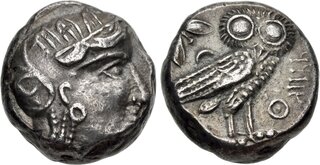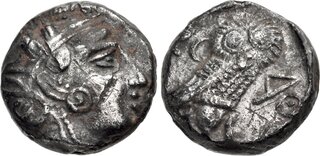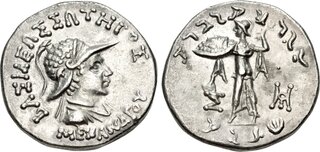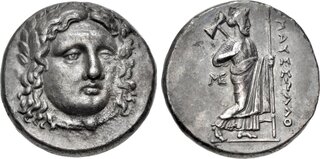Lot description:
PERSIA, Alexandrine Empire. Mazakes. Satrap of Mesopotamia, circa 331-323/2 BC. AR Tetradrachm (21.5mm, 16.90 g, 12h). Imitating Athens. Head of Athena right, with profile eye, wearing earring, necklace, and crested Attic helmet decorated with three olive leaves over visor and a pi-style palmette on the bowl / Owl standing right, head facing; olive spray and crescent to left, small Θ-like symbol and MZDK (in Aramaic) to right. Le Rider, Alexander, pp. 214-9; Van Alfen, Owls, Group IVb, 91–4 (same obv. die). Iridescent tone, a little off center, two test cuts on obverse, area of minor roughness on reverse. Good VF. Rare.
Ex Leu 83 (6 May 2002), lot 257.
Mazakes is best known as the Persian satrap who took over Egypt after Sabakes fell in battle against Alexander the Great's army at the Granicus, and later handed over the province peacefully to the Macedonian king. Imitative owls in the name of Mazakes have been known for some time, and all were originally attributed to his satrapy in Egypt. However, it was clear that stylistic elements separated the coinage into two general groups. More recent hoards, especially the 1973 Iraq hoard, have shown that one of the groups of imitative owls was certainly not struck in Egypt, but somewhere in the territory of modern day Iraq. In his analysis of the 1973 hoard, M. Price ("Circulation at Babylon in 323 B.C." in W.E. Metcalf, ed., Mnemata: Papers in Memory of Nancy M. Waggoner [New York, 1991], pp. 63–72) changed the findspot from Iraq to the more specific site of Babylon, based on anecdotal evidence (p. 63), and gave the series of Mazakes' owls to the city. However, such an assignment has forced numismatists to conduct mental gymnastics in order to rationalize the presence of Mazakes' coins at Babylon (cf. Van Alfen, Owls, pp. 27–33, and Le Rider, Alexander, pp. 215–7, for a summary of the previous research).
It is clear that the attribution of the owls to Babylon is almost certainly incorrect, and other find evidence suggests an attribution to somewhere further north, perhaps in the satrapy of Mesopotamia (cf. Le Rider, op. cit., p. 217–9). In any event, this coinage clarifies the historical record regarding the disposition of Mazakes following his hand-over of Egypt, upon which subject the literary evidence is silent. As noted by Le Rider (op. cit., p. 215), one can compare Mazakes to other Persians who peacefully welcomed Alexander to their domains: Mazaios, who handed over Cilicia, was later made satrap in Babylon; and Mithrenes, who surrendered Sardes, was made satrap in Armenia. Also, the Persian noble Amminapes, who met Alexander in Egypt with Mazakes, was later made satrap of Parthia and Hyrkania. Thus, one would expect Mazakes to receive similarly favorable treatment, appointment to some position of authority. Interestingly, Mesopotamia is the only satrapy that is not addressed in the literary evidence when Alexander is organizing his eastern territories. As these tetradrachms of Mazakes are found in that region, and date to the period after Alexander's conquest, it is reasonable to suggest that Mazakes may have been appointed as satrap of Mesopotamia. It was also in the adjacent satrapy of Babylonia that Mazaios was allowed to strike a coinage in his name and types (influenced by his prior issues at Tarsos) for local use, and similar issues of local type and weight are known to have been issued at mints throughout the basin of the Tigris and Euphrates, from the time of Alexander to Seleukos I. Thus, these Athenian type tetradrachms likely constitute a local coinage of Mazakes, struck in the satrapy of Mesopotamia while he reigned there.
Estimate: 2000 USD | 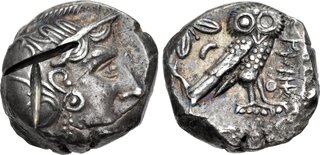 |

